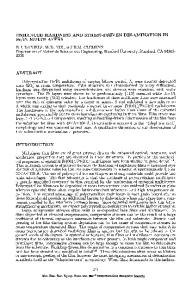Stress analysis of microwedge indentation-induced delamination
- PDF / 796,689 Bytes
- 7 Pages / 584.957 x 782.986 pts Page_size
- 81 Downloads / 444 Views
Tong-Yi Zhang Department of Mechanical Engineering, Hong Kong University of Science and Technology, Clear Water Bay, Hong Kong, China (Received 4 January 2009; accepted 24 February 2009)
The indentation stress is the key and fundamental parameter in indentation delamination tests, which are widely used in characterization of the interfacial fracture toughness (or adhesion) between a thin film and its substrate. The indentation stress was analyzed in the present work by using the finite element method for microwedge indenters of different wedge angles and with various other geometrical and mechanical parameters including the penetration depth, film thickness, delamination size, Young’s modulus, and yield strength of the indented film. The analysis exhibited the stress field under an indentation load and the stress field after unloading caused by plastic deformation, which resulted in the loading indentation stress and the unloading indentation stress, respectively, expressed by empirical formula in terms of the indenter geometry, the indentation depth, and the film thickness and mechanical properties. The energy release rate was also calculated for the indentation-induced interfacial crack.
I. INTRODUCTION
Characterization of mechanical properties of a film/substrate system, such as residual stress and interfacial fracture toughness, is of special interest and great importance because mechanical properties play essential and crucial roles in the reliability of micro/nanoelectromechanical systems (MEMS/NEMS). Among the available characterization techniques, the indentation delamination test is one of the popular experimental methods because of its userfriendly nature and thus is widely used in characterization of interfacial fracture toughness between a thin film and its substrate and in mutilayers.1–8 In 1984, Marshall and Evans1 and Evans and Hutchinson2 developed the indentation-induced delamination test by using a sharp-tip indenter. In their mechanics analysis, they used a simple model in which the section of film above the delaminating penny-shaped crack was treated to be an elastic disc with a clamped boundary. Then, the crack extension force was derived from changes in strain energy of the system as the interfacial crack extended. The resultant stress of indentationinduced stress and residual stress might buckle the delaminated film and thus provide an additional crack driving force. They derived the equilibrium crack length in terms of the indentation load and the indenter geomea)
Address all correspondence to this author. e-mail: [email protected]; [email protected] DOI: 10.1557/JMR.2009.0235 J. Mater. Res., Vol. 24, No. 6, Jun 2009
http://journals.cambridge.org
Downloaded: 16 Mar 2015
try, the film thickness and mechanical properties, the residual stress, and the fracture toughness of interface. The two works are the theoretical foundation of indentation delamination tests. The indentation-induced interfacial crack is always in a mixed mode. The interfacial fracture toughness depends on the phase
Data Loading...











